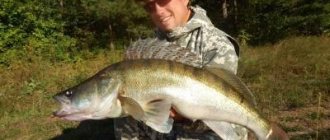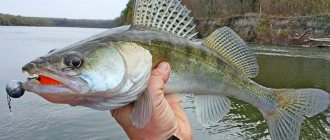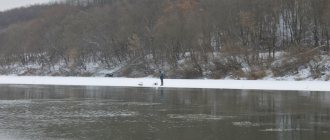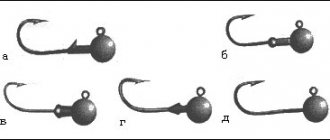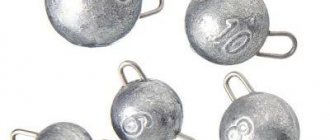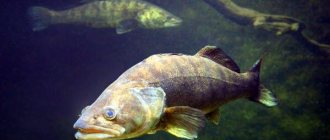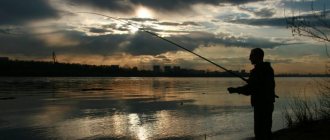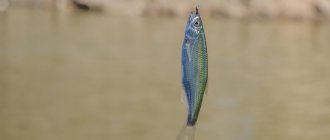Jig is the surest and best way to catch pike perch. Therefore, this type of fishing has a lot of fans among domestic spinning anglers. They are caught on medium and large rivers, reservoirs and lakes, in general, wherever the fanged inhabitant of the depths is found.
Jig fishing has the following advantages:
- wide variety of wiring
- huge variety and low cost of baits
- all-season
- opportunity to fish both from shore and from a boat
An additional advantage of the jig is that it does not require significant investment. Yes, there are expensive professional equipment. But any beginner can easily assemble a combat-ready set exclusively from budget rods, reels and lines.
Where to look for pike perch on a river or reservoir
You need to start by looking for promising places. As a rule, experienced spinning players keep such points secret and do the right thing. Therefore, you will have to be patient and use bait until your catch spots are developed.
Pike perch is a schooling predator. In one promising zone, not a single individual is clearly standing. Therefore, having found a catch point, you can take the “harvest” from it regularly throughout the season. Small predators form numerous schools, medium ones stay in groups of several dozen, and trophies mostly stand in groups of 2–5 specimens.
The fanged fish loves currents and a hard bottom. It cannot be found in standing water on soft muddy soil. The main places are:
- Edges and depth changes. On the riverbed, along a steep bank, near long ditches
- Snags. Solid and single driftwood, trees and large branches
- Pits and pools with a hard bottom. The predator chooses the deepest points for its sites
- Various anomalies at the bottom. Local tubercles and elevations, pits and depressions
When going fishing, you must initially choose places where the river bed turns. Here one bank will definitely be washed away. Over time, it becomes steep, sharp edges and slopes appear. If trees grow along it, then this indicates a snag in this place.
It is also recommended to study the river bed well. The fisherman should be interested not only in the pits themselves, but also in the entrances and exits from it. In addition, we must try to detect slopes and rifts with medium depths. Fanged often comes out here for lunch.
An interesting place will be the bridge over the river. It is deep here, there is a hard bottom, there is a strong current, there are a lot of shelters in the form of stones, construction debris and structure supports. The flow of water carries food for peaceful fish, and they, in turn, are in wait for a predator.
We must not forget about shallow water areas, especially sand spits and shallows, which are located near channel holes, snags and other pike perch areas. The predator comes out here mainly at night in summer, late spring and early autumn. Small individuals can hunt here even during the day.
Features of catching pike perch on a jig in the fall from the shore, boat and at night
Catching pike perch with a jig from the shore in the fall sometimes takes a lot of effort - the spinner has to walk more than one kilometer to get around promising places. Jigging for pike perch in the fall from the shore is sometimes very promising when it comes to drifting.
The boat significantly increases the fisherman’s capabilities, since in this case you can fish anywhere in the reservoir. A reliable anchor is an essential attribute of boat fishing. Catching pike perch with a jig in the fall from a boat when fishing on the river makes it possible to reduce the force of the current to zero during the retrieve if you cast along the current.
Video: catching pike perch in the fall from a boat with a jig
Considering that pike perch is a nocturnal predator, night jig fishing for pike perch is very productive. To do this, you will need a high-quality fishing rod with high tactile sensitivity.
Autumn pike perch for a spinning fisher is a long-awaited trophy that anglers wait for throughout the year. In a matter of tens of minutes, catching pike perch with a vibrating tail in the fall can bring a catch consisting of many tails. In addition, a large trophy specimen can be caught. Considering the gastronomic value of pike perch and the special caution of this fish, an army of pike perch fish storms water bodies in the fall.
Jig rig: the best method
The result of fishing in a particular place depends on the choice of equipment. The fisherman must be able to use different mounting options and know how to assemble them correctly. The wider the spinning player’s arsenal, the more successful he will be on the pond, regardless of the current situation.
The main jig equipment is:
- direct installation
- diverter leash
In addition to them, advanced anglers use Carolina and Texas rigs, drop shot, jig rig, split shot. Each has its own pros and cons. Direct mounting is a method of attachment in which the jig head is directly connected to the fishing line or leader. Its most common variety is a hinged rig on an eared sinker with a double hook.
Advice! When fishing in strong places, the double is replaced with an offset hook, increasing the passability of the equipment.
The retractable leash is designed for fishing various dumps, rifts and edges. It is mainly used on a clean bottom. Good results are achieved when hunting passive pike perch. Often the by-catch of this rig includes a hefty perch.
The best jig baits: how to choose the right option
Lures for jig fishing for pike perch are very diverse. Naturally, for most anglers, soft silicone products make up 90% of their entire arsenal. However, we must not forget about other options that, under certain circumstances, beat the usual “rubber”. So, these baits include:
- soft silicone baits
- foam fish
- front-loaded spinners
- jigs
- polyurethane foam fish
Of course, the classics are silicone twisters and vibrating tails. In addition to them, in fishermen’s boxes you can see various creatures, octopuses, worms, crayfish and slugs. “Rubber” can be ordinary or made from edible material. The latter is extremely popular and effective today.
We should also pay attention to slugs and passive worms without a movable sickle-shaped tail, made of edible silicone. These baits are extremely effective when fishing for sluggish and apathetic fanged fish. By performing slow movements or dragging them along the bottom, you can provoke a fish that was not even thinking about feeding at the moment to bite.
Products made of foam rubber and polyurethane foam have proven themselves in cold water, in particular in late autumn, winter and early spring. During this period, they are able to outplay silicone and other jig baits. Their additional advantage is their low cost.
Pinwheels and jigs, as a rule, are used by seasoned pike-perch fishermen. The main places where baits show consistent results are channel slopes and rifts, holes and ditches with a clean, hard bottom.
What colors are working?
The choice of bait color for pike perch depends on the season. During the warm period, preference should be given to warm and bright colors. Lime, green, yellow, red, orange, their combinations can give many memorable moments. In cold water you need to use dark baits:
- blue
- violet
- black
- dark grey
- dark green
At any time of the year, the presence of sparkles in the bait is welcome. However, you should always experiment, trying both matte and shiny options. White, pearlescent colors and their shades have performed well on many bodies of water. It is especially in demand in cloudy weather with light drizzle. The color works best at medium depths. It is advisable to install options with sparkles on the pits.
Spinning rod for catching pike perch
Spinning rods for fishing should be designed for comfortable night fishing. The rod itself should be light. This will not scare away the fish, but it is easier to break a dark rod in the dark than a white one. It is not recommended to paint the blank with varnish, as this can significantly change the structure of the rod for the worse. As already mentioned, when fishing for pike perch, a braided cord is used, and the rings must be of high quality so that it does not deteriorate.
When fishing for pike perch, the reel should also be at a high level. Size 1500-2000 according to Shimano classification. You can use heavier ones, but this will completely kill all the pleasure of fishing, where a light rod with a small reel allows you to feel all the resistance of the fish.
Those who fish with fairly heavy heads can use a multiplier. This is more practical than big non-profits. The cartoon will help you perform better wiring and is better suited for fishing from a boat. But it is not suitable for casting small Cheburashkas, and you cannot fish with light spinners with it at all. The most suitable cartoon for jig fishing is a small soap dish weighing 200-300 grams with a wide braking range. With this you can comfortably throw loads of 10-15 grams.
The spinning rod must be of suitable length. It greatly depends on the wiring technique used by the spinner. The size of 2.4 meters should be considered universal; it is suitable for both shore fishing and for a boat.
Particular attention should be paid to the balance of the rod. When fishing, the hand that holds the rod should be slightly below the reel, and the center of gravity of the entire tackle should also be there. This is necessary because when playing with an active bait you will have to work often and a lot with the tip of the rod. If your balance is poor, your hand will get very tired. You can correct the balance by slightly sharpening the handle.
The most convenient type of spinning rod handle for jigging is skeleton. This handle can be found on some kaida models in the mid-price range. They suffer from bad tips that can break, so you need to check them when purchasing by lightly resting the tip on the ceiling with the consent of the seller. If your budget is limited, then Kaida Phineas and Swagger are an excellent choice for catching pike perch with not very heavy baits. If you are lucky with the quality, you can fish for many years and be happy.
For those who have enough money for a good spinning rod, we can recommend a Silverado 742 ml stick for jig fishing for pike perch, which has a better test range, ringing and casting qualities, but also a better price. This stick is suitable for both inertia-free and small cartoons.
Fishing technique
This is why the jig is loved by many because it allows you to vary your retrieves, selecting the ones that are most catchy for specific fishing conditions and the mood of the fish. Moreover, it is quite simple to learn basic animation techniques, and with the accumulation of certain experience, they can easily master more complex fishing techniques.
The basis of most postings is the free fall of the bait and it must touch the bottom. This allows you to thoroughly fish the area, tapping every nook and cranny where a predator might be standing. In addition, the knocking on the ground and the rising cloud of turbidity additionally attract the attention of the predator, imitating a small feeding fish.
Which wiring to use
Basic jigging is a stepped one, in which the bait makes jumping movements, flying up and falling to the bottom. The fisherman must be able to correctly select the speed and height of its rise, as well as the time the equipment remains on the bottom.
As a rule, after casting the bait is allowed to sink to the bottom. Then, with a few quick turns of the coil, it is lifted up. There is a pause, she freely falls down and touches the ground. Then the cycle repeats.
An important point is the duration of the stop, during which the equipment lies on the bottom:
- If the predator is active, chasing the bait, then the pause ranges from 1 to 2 seconds
- The passive fanged one loves when the bait lies on the bottom for a long time. In this case, the stop can last up to 10 seconds, sometimes longer
- Standard wiring involves a pause of 2 to 4 seconds
If the classic “step” does not work, then it makes sense to try other animation options. For passive pike perch, dragging along the bottom performed well. To carry out this posting, you need to place a heavier load, and perform the feed slowly, trying to maintain continuous contact with the bottom.
Note! Sometimes you have to carry out stepwise wiring in the water column without touching the bottom. It is called wavy.
Often, experienced fishermen modernize the classic stepped retrieve by introducing additional jerking elements into it. This can be various explosions and twitching, swaying of the rod tip, pulling, recoil of the cord. The main thing is to force the pike perch to react to the bait by attacking it.
Selecting the right gear
A spinner who has competently and correctly assembled a balanced tackle that allows him to retrieve the bait, detect the bite of a predator, hook it and then reel it in can catch successfully and consistently.
The basic requirements for the gear are as follows:
- Sensitivity. Any bite must be noticed visually or tactilely. It is also important to maintain constant control over the bait during the retrieve.
- Rigidity. The bony mouth will not break through if the hooking is performed with “snotty” tackle. And if fishing is carried out from the shore and the predator takes it far, then this requirement becomes as relevant as possible.
- Power. This is a strong predator, therefore, in order to fish it out, the tackle must have a decent margin of safety. When fishing in snags, the fanged fish is pulled out in a forceful manner. With a flimsy set this is not possible.
- Range. Ballistic indicators of the gear are relevant when casting from the shore, when promising points are located on the riverbed.
The basis of any jig tackle is a spinning rod and always a braided cord. The rod chosen is fast action with a sensitive tip and a powerful butt part. The length depends on the conditions, varies from 2.1 to 3.3 meters. The bait test ranges from 10 to 45 grams. Sometimes “sticks” with a power of up to 60–70 grams are required.
The braid should have a breaking load of about 6–8 kg. It is important that the cord is resistant to abrasion and is not afraid of snags, shell rocks, pebble and rocky bottoms. The thread should not lose strength at the knots and be slippery in order to be able to make long casts.
The rod is equipped with a spinning reel size 3000–4000. Its spool must be spacious to be able to wind up to 150 meters of cord. It is better to take a power or universal model with a gear ratio from 4.2:1 to 5.1:1.
How to choose the head weight
The fishing result depends on the correct choice of head weight. A load that is too light will “fly up” and hang in the thickness, preventing the bottom from being thoroughly tapped. Too heavy, on the contrary, it will plow the soil and will not allow you to complete a full-fledged “step”.
When choosing the weight of the head, various factors must be taken into account:
- depths at the fishing spot
- current strength
- bait size
- wind strength and direction
- predator activity
- cargo shape
The most popular head shape is the “Cheburashka” or eared sinker. It is the most optimal and universal. For fishing in difficult places, it is advisable to use streamlined weights. The most in demand is the lead “bullet”.
The most popular are sinkers weighing from 15 to 45 grams. At shallow depths, it makes sense to lighten the equipment by placing from 8 to 12 grams. If fishing is carried out in pits with a strong current, then sometimes you have to weigh up to 50, or even 70 grams.
Bait
For pike perch, you should not use long baits; it is advisable to limit yourself to a length of 12 centimeters. There are several main options that pike perch take quite often. These include silicone twisters and vibrating tails. In addition, you can try foam rubber baits. Seasoned fishermen, as a rule, make fish from foam rubber with their own hands. It takes no more than 10 minutes to make. Most often they are made right at the fishing site. All you need is a simple dish sponge and scissors. An excellent option would be to make many baits of different shades and lengths at once.
Read: Pike on a spinning rod. Choosing tackle
What time of day does pike perch bite well?
This method can be used to fish all year round. This method of fishing allows the spinner to make forays into a body of water in any season, returning home with a catch. Naturally, there are periods when the predator eats sluggishly, there are also peak intervals when the fanged one experiences a gluttony:
- pre-spawning (second half of April, beginning of May)
- post-spawning (last week of May, beginning of June)
- autumn (from the second half of September to the end of October)
Note! In non-freezing sections of rivers you can fish with jig even in winter. Such places exist within the boundaries of many cities and large populated areas.
Pike perch can be caught all day long. Its activity peaks vary depending on the time of year and weather factors. In early spring it occurs mainly in the middle of the day. Just before spawning, the brightest burst of bites occurs at dusk, when it begins to turn gray, but can still be seen without a flashlight.
After spawning, the predator attacks in the late morning and afternoon, a little worse in the evening. With the onset of summer, the main activity shifts to the dark time of day. At night, the predator also takes exits:
- first hour after sunset
- about midnight to one o'clock
- before sunrise
Also in summer it takes place early in the morning. And in cloudy weather it can bite even during the day, but in the presence of a strong wind. In autumn, pike perch begins to feed during the day. The predator pecks at exits. The first surge is observed in the morning, followed by relative calm with rare contacts.
By lunchtime there is a second peak period, which lasts about an hour. The day ends with an evening hunt. Some anglers catch fanged fish at night, despite the cold weather.
Fishing throughout the year
Each period of the year has its own characteristics, which are expressed in behavior. There are peak periods when hunger is observed, and there are pronounced declines in activity, when the fanged fish behaves sluggishly, is capricious, and is difficult to provoke to bite.
Experienced spinning anglers involved in jig fishing are well aware of the habits of pike perch and the peculiarities of its behavior in specific bodies of water. That’s why they catch this strong, beautiful and desirable predator all year round, using their skills and accumulated experience.
In summer
Summer is the most difficult period in catching fangs. In early June, a post-spawning glutton of the predator is observed, but it is extremely short-lived. At this time, the pike perch takes it willingly and responds to various baits. Its main bite is observed in the morning and evening.
The predator then becomes passive. Extreme heat affects his behavior. Now he rarely bites during daylight hours, the bites are sluggish, so the results are inconsistent. Many fishermen completely give up fishing in the summer and in vain.
In summer, from the end of June to the second half of August, activity shifts to night time. As the sun sets, the predator begins to make periodic raids on the surrounding sandbanks and spits, eating bleak, juvenile roach and chub.
Important! The main bait for catching fanged at night is a shallow minnow class wobbler. All other things being equal, silicone on light jig heads loses in performance.
In the early morning, when it begins to get light, the pike perch moves to deep areas. The best places to catch it are sharp coastal edges. The predator moves along the boundary of the depth difference, periodically making throws after the gaping fry.
On cloudy, windy days it can also be active during lunch hours. The predator loves storms, when layers of water mix, lifting food from the bottom. At the same time, it is necessary to fish not only in the lower layers, it is necessary to explore the middle horizon. Lightweight jig heads and crank wobblers can help.
in autumn
At the beginning of autumn, activity increases sharply. The cooled water encourages the predator to feed, greedily attacking the offered bait. The autumn zhor is the longest and most stable; even a novice spinning angler can catch fish.
In the first half of autumn, while there are warm, fine days, pike perch feeds mainly in the morning hours. As a rule, it begins to take a little after sunrise. Active until approximately 10–11 am. Then the bite subsides and resumes in the evening. May last until dusk.
Note! In autumn, the nocturnal activity of pike perch decreases, but large individuals continue to feed in the dark.
From the second half of October, when the temperature of both water and air drops significantly, the bite shifts to the middle of the day. Now he doesn’t always wake early in the morning, but wakes up only at 8–9 o’clock. The second surge is observed at lunchtime, and it all ends with a short evening exit.
In the second half of November and early December, just before the freeze-up, activity drops to almost zero. The predator is inactive, is not ready to chase the bait, and it becomes very difficult to tempt him to bite. During this period, the best time to try to take at least one specimen is between 10 and 14 o'clock in the afternoon.
in winter
Fishing in winter with jigs is carried out in ice-free sections of rivers. As a rule, this is an area of large settlements, various industrial enterprises, and thermal power plants that discharge warm water into the main channel. There are few fans of this type of fishing, since low temperatures do not allow them to fully enjoy spinning fishing.
In winter, fangs are searched for in riverbed areas far from the shore. It occupies medium and large depths, choosing various dumps, rifts, entrances and exits from pits, and extended ditches. It is practically not suitable for the coastal zone, with the exception of steep banks with sharp edges.
Activity in winter occurs in the middle of the day. The predator attacks mainly from 11 a.m. to 2 p.m. In the early morning and evening, its bites occur rarely, are inconsistent, and therefore impossible to predict.
The best bait for winter hunting are foam fish. They even beat silicone, allowing them to provoke a passive predator to bite. In addition to the classic hinged equipment, it is recommended to use a diverting leash, especially when fishing remote riffles and dumps.
In winter, the best time to catch pike perch is in early December. Then, in January, with the onset of deep winter, the predator hardly takes, getting hooked only sporadically. From the second half of February it gradually wakes up. A surge of activity occurs during the thaw.
Article by Kirill Kozlov » Pike perch on a jig at night? Why not!"
One day on a windy, chilly October day, by chance I was late fishing. The fishing took place from the shore on the Oka River and despite the rather uncomfortable weather, the fish were biting. The pikes did not react badly to silicone baits, and the handsome asp was a surprise.
I have noticed more than once that when you walk on the water in a boat with an echo sounder and tack over a promising area, you mark for yourself certain landmarks on the shore. A tree leaning toward the water, a fluffy bush, tall flyers from borers, a pile of garbage in a trampled area, etc. So, at one of these places I was first caught by twilight, and not long later by complete darkness.
At some point I regretted not taking a box of wobblers with me to try to catch a night walleye. On the other hand, the depth at the outflow in that place was about four meters, that is, a small local groove with a hard bottom and some snags. Why not carefully fish this place with a jig?
After several hours of unsuccessfully rinsing various jig baits, the eyes completely adapted to the pitch darkness. I turned on the flashlight only to change the next bait. At night, you won’t see the tip of the spinning rod playing back or the cord sagging; here vision is replaced by feelings, first of all, of your rod. After another snag on a snag, I began to hide the tip of the offset hook in the bait and moved a little further upstream. But time passed and there was no bait left in the box that I wouldn’t try, and there were still no bites. Having poured the remaining tea from the thermos, I simply sat down. By this time, a strong wind had dispersed all the clouds and a beautiful starry sky was revealed above me. There was almost complete calm on the river, only occasionally the faint presence of wind was felt due to minor ripples on the water. It became noticeably colder. Having decided to make a few more casts in this, in my opinion, promising place, and slowly, since the shore is slippery, move towards the car. Literally on the very first postings, I began to feel the presence of a white fish that came from what is called “out of nowhere.” At night it is difficult to estimate the distance and, accordingly, the casting range. It seemed to me that this time I cast not much further, the green Typhoon did not sink to the bottom for a long time, automatically I began to raise the rod and felt the heaviness, I hooked and the first, long-awaited pike perch bit on the very release and even on the fall.
It seemed to me that he was desperately trying to escape into that very snag that was located somewhat lower downstream. But thanks to the powerful Spring, I forced the fishing and the already tired fish on the sandy shore sparkled its eyes in the light of the lantern.
Exit? Flashed through my head. It's a quarter to eleven. Several hasty casts “to the same place” naturally turned out to be empty. The right decision turned out to be to slow down the pace of these very casts, but whatever, stop gushing the water and still think about it. Since the pike perch bit at the very release, it was necessary to increase the weight of the weight, which is exactly what I did. Now the pause in the fall was only a second, one and a half, or maybe two. Another cast into complete darkness, a distinct plop of the bait into the water, the first two turns after the first fall of the bait to the bottom, a good click - there it is! A rush of emotions and adrenaline turned on the light above the river for a moment. I saw and heard everything. A beautiful bend of the spinning rod, a cord going downstream. The sound of the clutch brought me back to reality, I frantically tried to tighten it, but it was too late. The fish found this snag and got off safely. Naturally, I did not tighten the clutch nut after the previous fishing...
Time? Almost one o'clock in the morning. A bunch of intertwined emotions from joy to resentment. The crackling of the clutch continues in my ears... It got even colder, but that doesn’t matter anymore. Searching for baits, running up/downstream, is it really all over before it even begins? On the next cast I knock on the leucorrhoea and again find this ill-fated snag. I leave the catchy Typhoon on it. This was the last bait. Rummaging through my backpack, I dig out the same green Noise. I'm bandaging myself. I pre-knit leashes made of thick fluorocarbon and powerful fittings the day before fishing. Therefore, dressing does not take much precious time. Yes, the bait is a little larger and will probably fly a little closer. Probably none! The pause increased by a fraction of a second. A familiar click - yes! This time there is a beautiful parabola from Spring and no chance of getting off. Forced fighting. The handsome man on the shore spread his spiny fin and tucked his tail slightly in my direction.
Time? Beginning of four. Eat!
Time? Almost four. Eat!
The following postings. Belle is missing. This was the final one for yesterday, although already for today...
As often happens, subsequent trips to the same place were not successful. But I always keep two or three of these in stock. On which the same thing happened regularly. October quietly flowed into November, and the topic of night jigging pike perch became more and more interesting.
Later it turned out that the places in which pike perch bites did not have to be outstanding and with stunning relief, the presence of white fish and some more or less depth at least somewhere nearby was enough. If there are snags, then you are generally on the right track. Often in such places, pike perch makes itself known on a completely white day, and this is already a good sign.
I already began to catch myself thinking that I was becoming some kind of hunter, a hunter of night pike perch. But a pike regularly caught in the dark completely drove away these thoughts. By the way, burbots also do not disdain silicone baits, although not so often.
Usually, when fishing on the shore, I rarely stay in one place, as for me, running around the river is much more interesting. But night fishing is a big exception. If you know a good place that meets the parameters described above, then rest assured that pike perch will definitely show themselves there, and not only pike perch.
Your patience and, I would say, perseverance play a big role here. And the main thing, in my opinion, is the frequent change of bait, not only for size, geometry and color, but in general for character. These can be various vibrating tails with active play, foam fish, all kinds of silicone worms, or anything. As an example, literally not a long time ago fishing from a boat.
From dawn until dusk, I checked the so-called “prominent” places on the river, with good relief and where a predator was constantly present. But apart from one near-killing fish, we were unable to catch anything else.
As dusk fell, I found myself on an absolutely flat but hard bottom with a depth of two and a half meters and one single snag. And maybe it’s not a snag at all, but blind hooks happened in this place regularly, even seemingly with absolutely no snags.
Above this hold the river current intensified, below it it was calmer. I didn't have an echo sounder with me. I just fished this structure without reaching it. When it became completely dark, I stopped controlling the distance to this anomaly because it is located approximately in the middle of the river. Since I had to return upstream to the car, I therefore climbed not much higher than this place. I was sorting through the baits. Peered into the darkness. I sharpened, so to speak, all my senses with each subsequent cast. At some point, I turned on the flashlight and began to collect the scattered baits into a box, thereby completing this fishing trip. Something inside told me to make a few more casts and go home. On the next one there seemed to be a bite, but I didn’t notice any traces anywhere. Literally the next cast and HE sat down. I certainly understood immediately that there was a serious fish on the other end, but I was more worried about that dull hook. I never turn on the flashlight at the fishing stage, but here I thought it was a special case. It wouldn’t be out of place to say that Spring coped with the fish and simply didn’t give it the slightest chance, and the handsome pike perch weighed 9.065 kg for a minute...
And this and many other examples indicate that the fish we are interested in, especially in the dark, can end up anywhere. Well, I definitely have no doubts about the choice of gear and bait!
NHNCH to everyone and see you at the reservoirs.

